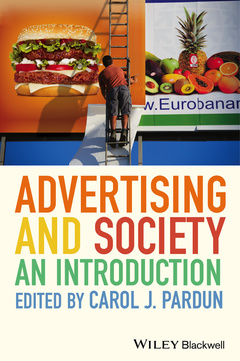Description
Advertising and Society (2nd Ed.)
An Introduction
Coordinator: Pardun Carol J.
Language: English
Subject for Advertising and Society:
Keywords
case studies, textbook, media ethics, advertising ethics, business ethics, advertising technology, privacy, targeted advertising, direct to consumer, B2B, B2C, internet marketing, data mining, political advertising, stereotypes in advertising, super bowl, tv commercials, media studies, sociology, communication studies, debates, mass communications and society, broadcasting, electronic media, advertising research, children and advertising
312 p. · 17.2x24.4 cm · Paperback
Description
/li>Contents
/li>Biography
/li>
- Expanded with five new chapters covering the impact of emerging technologies, including the evolution of Direct to Consumer (DTC) pharmaceutical advertising; product placement in various media; and the growing intrusiveness of Internet marketing
- Explores a broad range of topics including alcohol, tobacco, and sex in advertising; the pros and cons of negative political adverts; advergrames; and the use of stereotypes
- Examines the impact of advertising through its distinctive ?point/counterpoint? format ?designed to spark discussion and help students understand the complexities of the issues being presented
- Lends substantial clarity to the subject, uniquely balancing criticism and practice within one text
- Includes chapter-level overviews and summaries of the topic history and key issues, along with student-friendly features such as ideas for papers and questions for discussion
Notes on Contributors viii
1 Introduction: Why Does Everyone Have an Opinion about Advertising? 1
Carol J. Pardun
Part I Enduring Issues 7
2 The Economic Impact of Advertising 9
ARGUMENT C. Ann Hollifield 12
Advertising lowers prices for consumers 12
COUNTERARGUMENT Penny Abernethy 17
Advertising makes products more expensive 17
3 Advertising to Children 24
ARGUMENT J. Walker Smith 28
Children are smarter than we think. Let’s respect them as the consumers they are! 28
COUNTERARGUMENT Dan Panici 34
Children need more protection from advertising! 34
4 Political Advertising 43
ARGUMENT Anne Johnston 45
What’s so positive about negative advertising? 45
COUNTERARGUMENT Albert R. Tims 52
Why negative political advertising is bad advertising 52
5 Tobacco Advertising 61
ARGUMENT R. Michael Hoefges 64
The strong First Amendment right to promote lawful products
COUNTERARGUMENT Timothy Dewhirst 74
Rationales for the regulation of tobacco advertising and promotion 74
6 Alcohol Advertising 84
ARGUMENT Jon P. Nelson 87
Not so fast! Evidence-informed alcohol policy requires a balanced review of advertising studies 87
COUNTERARGUMENT Esther Thorson 96
Abandonment of alcohol advertising regulation carries a high social cost 96
7 Sex in Advertising 106
ARGUMENT Tom Reichert 108
Sex in advertising: No crime here! 108
COUNTERARGUMENT Kathy Roberts Forde 113
Using sex in advertising is never a good idea 113
8 Stereotypes in Advertising 121
ARGUMENT Jane Marcellus 124
What’s the harm in advertising stereotypes? 124
COUNTERARGUMENT Margaret Morrison 130
Stereotypes are a necessary and appropriate strategy for advertising 130
Part II Emerging Issues 135
9 Direct-to-Consumer Pharmaceutical Advertising 137
ARGUMENT Beth E. Barnes 139
Doctor knows best: Why DTC advertising of prescription medications is bad for patients 139
COUNTERARGUMENT 1 Michael L. Capella and Charles R. Taylor 146
Pharmaceutical DTC advertising provides valuable information to health-care consumers 146
COUNTERARGUMENT 2 Debbie Treise and Wan Seop Jung 154
Feel empowered! Enhanced health knowledge! 154
10 Hyper-Niche Markets and Advertising 161
ARGUMENT Joe Bob Hester 164
Hyper-targeted and social: Why Facebook advertising may be advertising at its best 164
COUNTERARGUMENT Tom Weir 169
Today is the new 1984: Big Brother is not only watching you – he is selling to you 169
11 Advertising and Product Placement in Entertainment
Media 175
ARGUMENT Geah Pressgrove 179
Product placement is simply good advertising strategy 179
COUNTERARGUMENT Kathy Brittain Richardson 186
Placing products in entertainment media does not enhance the media experience 186
12 Advertising in Previously Hands-Off Journalistic Environments 191
ARGUMENT Beth E. Barnes 193
This is news? Maybe not, but that’s okay! 193
COUNTERARGUMENT Charles Bierbauer 200
Advertising in strong journalistic environments is never a good idea 200
13 Advergames 208
ARGUMENT Adrienne Holz Ivory and James D. Ivory 210
Food and beverage advergames are playing with children’s health 210
COUNTERARGUMENT Kevin Wise and Saleem Alhabash 218
Evidence of advergame effectiveness 218
14 Advertising and Sporting Events 229
ARGUMENT Erin Whiteside 232
Advertising unhealthy products during sporting events makes sense as an advertising strategy 232
COUNTERARGUMENT Marie Hardin 239
Sporting events and advertising products are contrary to athletes’ lifestyles: The consequences of mixed
messages 239
15 Advertising to Captive Audiences 246
ARGUMENT Angeline G. Close 248
Why advertising is acceptable (almost) everywhere 248
COUNTERARGUMENT Charles Pearce 259
Who wants to be held captive by advertisers? Not me! 259
16 Advertising and Social Responsibility 265
ARGUMENT Debra Merskin 267
Companies are wise – and ethical – to use “social responsibility” as a creative strategy 267
COUNTERARGUMENT Peggy Kreshel 275
Cause-related marketing as a business strategy is ethically flawed 275
Index 295




